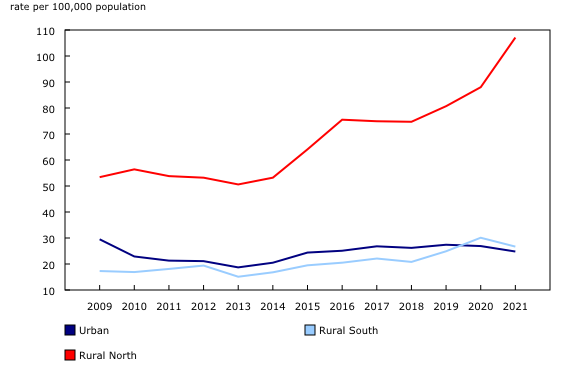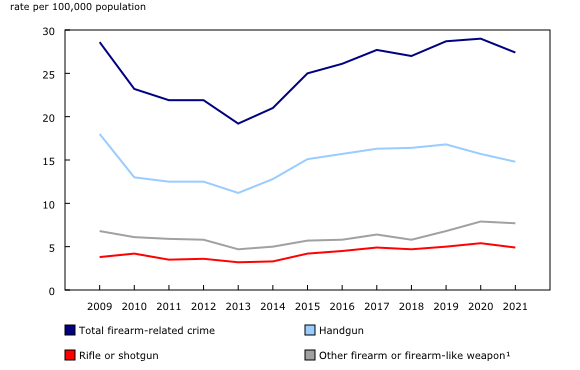Firearms and violent crime in Canada, 2021
Released: 2022-12-12
While police-reported violent crime in Canada increased 4% from 2020 to 2021, the rate of firearm-related violent crime decreased 5%. Despite this recent decline, firearm-related violent crime has generally been increasing since the early 2010s. The rate of firearm-related violent crime in 2021 was 25% higher than it was a decade earlier in 2012.
As has consistently been the case in Canada, violent crime involving firearms accounts for a small proportion of all crime that is brought to the attention of police. In 2021, the 8,047 victims of firearm-related violent crime represented 2.6% of all victims of violent crime.
Unlike the trend seen in firearm-related violent crime in general, the rate of shooting homicides was up 6% in 2021. This marked the highest rate of police-reported shooting homicides since 1992 and, at 297, the most homicides by firearm ever recorded.
The Juristat Bulletin – Quick Fact article "Firearms and violent crime in Canada, 2021," published today, presents the most recent police-reported data on firearm-related violent crime in Canada, based on the Uniform Crime Reporting Survey and the Homicide Survey.
Decline in firearm-related violent crime driven by decrease in Ontario
Ontario was the main driver of the overall decline in firearm-related violent crime from 2020 to 2021, with 522 fewer victims of firearm-related violent crime in this province in 2021. More specifically, the overall decrease was largely attributable to declines in the Toronto census metropolitan area (CMA), where there were 405 fewer victims and a 22% decrease in the rate of firearm-related violent crime compared with 2020.
After Ontario, the next largest decreases were recorded in Alberta, British Columbia and Nova Scotia. In both Alberta and British Columbia, the decreases at the provincial level were the result of substantial declines in the rural South. In Nova Scotia, the decrease was related in part to the April 2020 mass shooting, where 22 people were killed and others were injured—the deadliest mass shooting in Canadian history.
These declines in the number of victims from 2020 to 2021 were somewhat offset by increases in Manitoba, Saskatchewan and Nunavut. Notably, Regina, Winnipeg and Saskatoon had the highest rates among CMAs in 2021 and, in all three cases, saw increases compared with 2020.
In 2021, the highest rates of firearm-related violent crime among the provinces were recorded in Saskatchewan (83 per 100,000 population) and Manitoba (58). In contrast, the lowest rates were in British Columbia (18), Newfoundland and Labrador (15), and Prince Edward Island (7).
Firearm-related violent crime down in urban areas and the rural South, but up in the rural North
Beyond the decline at the national level, there were varying trends in firearm-related violent crime across the provinces and territories, notably when comparing the rural North, the rural South and urban areas. For the purposes of this analysis, the rural North includes all rural police services in the territories and the northern regions of Newfoundland and Labrador, Ontario, Manitoba, Saskatchewan, Alberta, and British Columbia. The rural South refers to rural police services in the southern regions of these provinces, as well as those in Prince Edward Island, Nova Scotia and New Brunswick.
In 2021, the rate of firearm-related violent crime was 107 victims per 100,000 population in the rural North, approximately four times higher than the rates in the rural South (27) and urban areas (25). These geographic differences are similar to what is seen with violent crime in general.
Compared with 2020, urban areas (-8%) and the rural South (-11%) recorded decreases in their rates of firearm-related violent crime. In contrast, there was a 22% increase in the firearm-related violent crime rate in the rural North, which reached its highest point since comparable data became available in 2009. The highest rates of firearm-related violent crime in the provinces were generally seen in the rural North. For instance, rural Northern Saskatchewan recorded the highest rate in the country (467 victims per 100,000 population) for the seventh consecutive year.
As with crime rates overall, the higher rates of firearm-related violent crime recorded in the North and their greater variability over time reflect the comparatively smaller populations of these areas. For instance, while rates were higher in the Northern regions of the country, firearms were present in a similar proportion of incidents in urban areas (2.6%), the rural South (2.4%) and the rural North (2.5%).
Handguns more commonly present in urban areas, while rifles or shotguns more often present in rural areas
Consistent with past trends in firearm-related violence, handguns were more often present in urban areas than in rural areas. In 2021, handguns accounted for over 6 in 10 firearm-related violent crimes (63%) in urban areas, well above what police reported in the rural South (26%) and rural North (20%). In contrast, in rural areas, rifles or shotguns were most common—they were present for about 4 in 10 victims of firearm-related violent crime (38% in the rural South and 40% in the rural North).
Overall, over half of firearm-related crimes involved a handgun, making handguns the most common type of firearm present. Although they were the most common, the rate of handgun-related violent crime declined 6% in 2021, marking the lowest rate since 2014.
A rifle or shotgun was present for close to one in five victims of firearm-related violent crime (18%) in 2021. The rate of violent crime involving a rifle or shotgun declined 8% in 2021.
Shooting homicides reach highest rate since 1992
Police in Canada reported 297 homicide victims whose cause of death was shooting in 2021. This represented a rate of 0.78 victims per 100,000 population, marking a 6% increase from the previous year and the highest rate recorded in Canada since 1992.
The rise at the national level was driven by increases in the number of reported shooting homicide victims in Ontario (+20), British Columbia (+14) and Quebec (+6), which were partially offset by declines in Alberta (-15) and Nova Scotia (-12).
Shooting homicides accounted for 40% of all homicides in Canada in 2021, making shooting the leading cause of death among victims of homicide for the sixth consecutive year. Shooting was followed by stabbing (32%), beating (17%) and other methods (10%).
As has been the case each year since 1995, handguns (57%) were the most common type of firearm used in shooting homicides in Canada in 2021, followed by rifles or shotguns (26%). Nearly all victims of handgun homicides (95%) in 2021 were in urban areas. Homicides committed with a rifle or shotgun were dispersed differently throughout the country, with 56% in urban areas, 28% in the rural South and 15% in the rural North.
As with firearm-related violent crime in general, the rate of firearm homicide was higher in the rural North (1.52 victims per 100,000 population), well above that recorded in urban areas (0.76) and the rural South (0.69).
Close to half (46%) of all shooting homicides in 2021 were confirmed or suspected to be related to gang activity, according to police, compared with 7% of homicides committed via any other method.
Note to readers
This article is based on a Juristat article examining police-reported firearm-related violent crime using data from the Uniform Crime Reporting (UCR) Survey—an annual census of all crime reported to federal, provincial, territorial and municipal police services in Canada—and the Homicide Survey, an annual census of all homicides that come to the attention of police.
All results from the UCR in the current article exclude the province of Quebec because of a large proportion of incidents where the most serious weapon present was reported as unknown. They also exclude data for the Saint John police service because of data quality concerns. Information on homicides from the Homicide Survey represents all of Canada, including Quebec.
In this study, firearm-related violent crime refers to victims of violent crimes where the most serious weapon present in the incident was a firearm and where police deemed the presence of the firearm relevant to the incident. For an incident to be considered firearm-related, a firearm need only be present during the commission of the offence, not necessarily used. This measure excludes non-violent Criminal Code offences where a firearm was present, including administrative offences (such as unsafe storage) or firearm-specific violent offences (such as discharging a firearm with intent where there was no victim identified).
Rural police services are those where the majority of the population lives outside a census metropolitan area (CMA) or census agglomeration (CA). Urban police services are those where the majority of the population lives within a CMA or CA.
The rural North includes all rural police services in the territories or in the provincial North. The provincial North encompasses the northern regions of Newfoundland and Labrador, Quebec, Ontario, Manitoba, Saskatchewan, Alberta, and British Columbia (North and South - Variant of Standard Geographical Classification 2016). The rural South refers to rural police services in the southern regions of these provinces, as well as those in Prince Edward Island, Nova Scotia and New Brunswick. As data from Quebec are excluded, analysis of firearm-related violent crime in the North and South excludes the northern and southern regions of Quebec.
Products
The Juristat Bulletin – Quick Fact article "Firearms and violent crime in Canada, 2021" (85-005-X) is now available.
Contact information
For more information, or to enquire about the concepts, methods or data quality of this release, contact us (toll-free 1-800-263-1136; 514-283-8300; infostats@statcan.gc.ca) or Media Relations (statcan.mediahotline-ligneinfomedias.statcan@statcan.gc.ca).
- Date modified:


